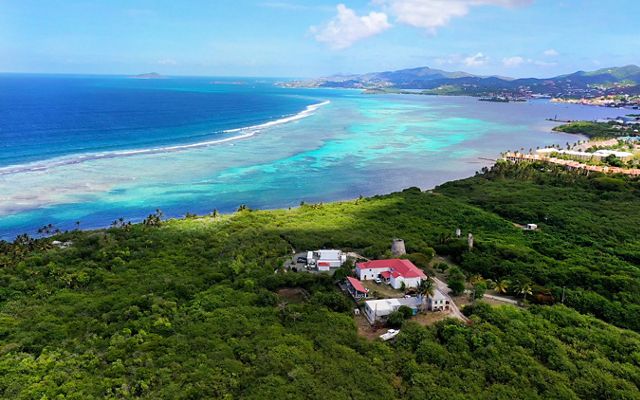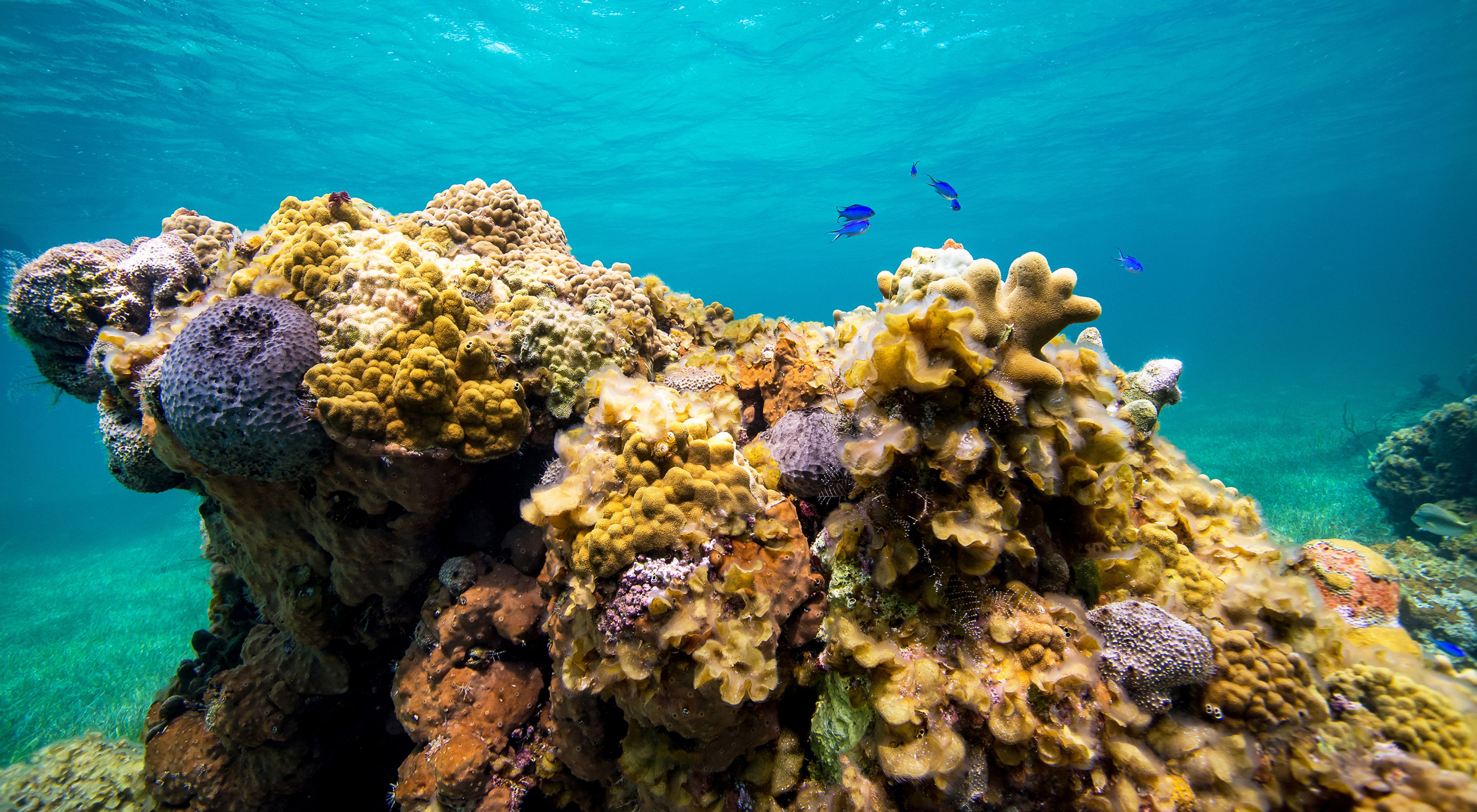The Nature Conservancy Dedicates New Coral Innovation Lab in Saint Croix
The new laboratory is dedicated to advancing coral science in the Caribbean and across the planet.
Media Contacts
-
Kelley Galownia
The Nature Conservancy
Phone: (571) 403-4625
Email: kelley.galownia@tnc.org
The Nature Conservancy today celebrated the grand opening of its U.S. Virgin Islands Coral Innovation Hub, a new laboratory dedicated to advancing coral science in the Caribbean and across the planet.
Located at Estate Little Princess—a historic plantation site situated northwest of Christiansted in Saint Croix—the U.S. Virgin Islands Coral Innovation Hub will serve as a center for innovative approaches to coral conservation. New coral science and technology developed at the Hub will be distributed through a global network of conservation practitioners, partner organizations, stakeholders and educators to advance coral conservation worldwide.
Quote: Governor Albert Bryan, Jr.

Here in the Caribbean, we are on the frontlines of large-scale coral restoration. We are proud to partner with The Nature Conservancy and partners to protect this critical resource.
U.S. Virgin Islands Governor Albert Bryan, Jr. was joined at the grand opening by Jennifer Morris, CEO of The Nature Conservancy; Frandelle Gerard, Executive Director of Crucian Heritage and Nature Tourism; Celeste Jarvis, Virgin Islands Program Director of The Nature Conservancy; Dr. Ayana Flewellen, President of the Society of Black Archaeologists; Jennifer Koss, Coral Reef Conservation Program Director of the National Oceanic and Atmospheric Administration (NOAA); and Angelita Alvino, St. Croix Superintendent of the National Park Service.
“The Caribbean is home to some of the planet’s most magnificent coral reefs, which harbor abundant ocean life, protect coastal communities and support nearly half of the region’s economy,” says Dr. Celeste Jarvis, Virgin Islands Program Director of The Nature Conservancy. “Today, these essential habitats are in grave decline due to climate change, overfishing and pollution. The launch of The Nature Conservancy’s U.S. Virgin Islands Coral Innovation Hub represents an important beacon of hope for coral reefs throughout the Caribbean.”
In Saint Croix's East End Marine Park, The Nature Conservancy, NOAA and the National Fish and Wildlife Foundation are spearheading one of the Caribbean's largest coral-restoration initiatives, spanning more than 150 acres of reef area. Thanks to a partnership with the National Park Service, these efforts will expand broadly across vital U.S. Virgin Islands waters.
These efforts—in concert with work at The Nature Conservancy’s Coral Innovation Hubs in The Bahamas and the Dominican Republic—are mobilizing world-class science and a global network of partners to help imperiled reefs before it is too late.
At the new U.S. Virgin Islands lab facility, The Nature Conservancy and partners are advancing coral science and techniques to help reefs recover on a larger scale than ever before and with greater long-term impact.
Using The Nature Conservancy’s land-based and underwater nurseries, scientists are innovating ways to breed significantly more corals for reef restoration, with greater survival rates. A combination of novel techniques allows these scientists to dramatically increase coral growth and preserve coral genetic diversity for improved reef resilience. Healthy new corals are then used to bring dying reefs back to life and restore the benefits they provide for the ocean, communities and economies that depend on them.
The Evolution of Estate Little Princess
For more than 30 years, The Nature Conservancy has protected the diverse flora and fauna of the 25-acre nature preserve at Estate Little Princess. Today, The Nature Conservancy is working to restore the historic buildings of Estate Little Princess and bring awareness to its role in the history of racial injustice and slavery. At the same time, the organization is striving to transform the preserve into an international nucleus of innovation to enhance coral reef, coastal, community and economic resilience in the Virgin Islands and throughout the Caribbean.
For more than a century, hundreds of enslaved Africans labored at Estate Little Princess. Before them, the Tainos and other Indigenous Peoples sustained these lands, which were later occupied by European settlers. Limited artifacts remain to document the lives of the enslaved or indentured, but The Nature Conservancy and the Society of Black Archaeologists (SBA) are committed to honoring those who lived and labored at Estate Little Princess. The Society of Black Archaeologists has played an enormous role in uncovering and telling their stories.
Quote: Dr. Ayana Omilade Flewellen
Estate Little Princess sits at the intersection of natural and cultural preservation needs that are rooted in hard history; the work of the Society of Black Archaeologists, TNC and partners creates a brighter future.
“It has been a joy witnessing how the work at Estate Little Princess has grown to be even more dedicated to environmental conservation and historic cultural preservation,” says Dr. Ayana Omilade Flewellen, President of the Society of Black Archaeologists. “Estate Little Princess sits at the intersection of natural and cultural preservation needs that are rooted in hard history, but the work of the Society of Black Archaeologists, The Nature Conservancy and partners creates a brighter future.”
The historic buildings of Estate Little Princess are made of stony corals and limestone from the sea. Partners of this project say it is fitting that the historic buildings are now the home of The Nature Conservancy’s U.S. Virgin Islands Coral Innovation Hub—a place for scientists to gather, community members to learn and young conservationists to be inspired.
“Estate Little Princess connects the human history of enslaved Africans, planters of the estate and everyday lives of people who lived on the sugar plantation for more than 200 years,” says Olasee Davis, Extension Professor in the Natural and Cultural Resources of the University of the Virgin Islands, School of Agriculture. “I am excited for the next chapter in the evolution of Estate Little Princess historic site, where the cultural, natural and marine resources are stewarded by The Nature Conservancy leadership in the 21st century.”
A Beacon of Hope for Coral Reefs in the Caribbean and Beyond
Hidden beneath the surface of the sea, coral reefs are among the richest ecosystems on Earth and supply communities around the world with food, livelihoods and protection against environmental threats. Coral reefs benefit approximately 500 million people worldwide each day and provide habitat for 25% of all marine species.
Despite their benefits, coral reefs have reached a crisis point, pushing many of the species that depend on them to the verge of extinction. In the last three decades alone, more than half of the world’s corals have disappeared, including large swaths of the iconic Great Barrier Reef. Scientists estimate that if the threats to reefs are not confronted, 90% of coral reefs could be gone within our lifetimes, which would gravely impact the people and species that depend on them.
Quote: Frandelle Gerard
The restoration and preservation of our reefs will provide the next generations with food security and environmental security in the face of the growing pressures of climate change.
The Caribbean—home to 10% of the world’s coral reefs and more than 12,000 marine species—is not immune to these threats. In fact, the region’s coral reefs are on the frontlines of what many reefs are facing worldwide. Scientists estimate that living coral cover in the Caribbean has decreased by 60% in the past three decades alone, as climate change, overfishing, removal of mangroves and pollution are causing reef degradation at a catastrophic rate.
"The ocean and coral reefs are vital to our culture and our existence—they sustain our fishing traditions and are a central element of our tourism economy,” says Frandelle Gerard, Executive Director of Crucian Heritage and Nature Tourism. “The Nature Conservancy at Estate Little Princess highlights the value of conservation and preservation of our natural and built environment. The restoration and preservation of our reefs will provide the next generations with food security and environmental security in the face of the growing pressures of climate change.”
Quote: Jennifer Morris
Transforming Estate Little Princess into a center for scientific discovery also helps this community to be resilient while protecting life and livelihoods across the Caribbean and the world.
In 2020, The Nature Conservancy and partners released a groundbreaking tool for ocean conservation, using a novel suite of remote sensing technologies. The Caribbean Marine Maps identified, for the first time ever, the location and status of all coral reefs, seagrass beds and other underwater oases of life throughout the region. These maps are now being used to identify coral reefs that are most likely to be resilient in the face of climate change. The findings help governments and organizations determine where investments in reef conservation will have the greatest long-term impact because those areas are naturally more adaptable to changing conditions.
“The Nature Conservancy has been a leader in coral conservation for decades, and we now have a multifaceted approach to restore the long-term health of coral reef ecosystems, increase their resilience to the climate crisis and address the threats that have caused their deterioration,” says Jennifer Morris, CEO of The Nature Conservancy. “Transforming Estate Little Princess into a center for scientific discovery also helps this community to be resilient while protecting life and livelihoods across the Caribbean and the world.”
The Nature Conservancy is a global conservation organization dedicated to conserving the lands and waters on which all life depends. Guided by science, we create innovative, on-the-ground solutions to our world’s toughest challenges so that nature and people can thrive together. We are tackling climate change, conserving lands, waters and oceans at an unprecedented scale, providing food and water sustainably and helping make cities more sustainable. Working in more than 70 countries and territories, we use a collaborative approach that engages local communities, governments, the private sector, and other partners. To learn more, visit nature.org or follow @nature_press on Twitter.
